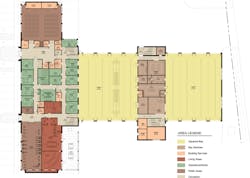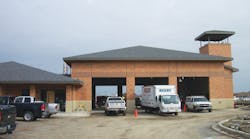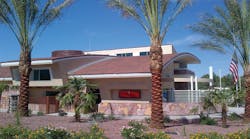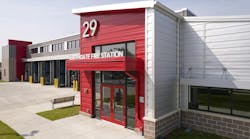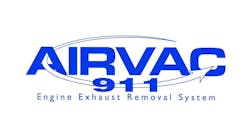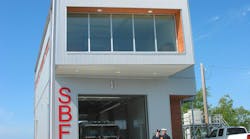Download the full PDF of the Station Design supplement here:
View Firehouse’s collection of supplements and special content at firehouse.com/special-content.
Why is it that emergency service professionals are so respected by the public at large? Is it because these men and women put their own personal well-being at risk by running into burning buildings, by cleaning up hazardous materials spilled on the highway or by controlling chemical fires?
Are they admired because they are always on call, 24 hours a day, to be there to help a loved one suffering a heart attack or to extricate a trapped victim in an upended vehicle on the highway?
Of course, the answer is yes to all of the above reasons and more. Yet, what is the cost paid by our emergency service professionals for the essential role they play in the well-being of our communities?
The risk
The human price of fire and rescue service is being increasingly recognized and voiced in studies that go beyond budget reports and staffing plans. Emergency service professionals are classified by the insurance industry as high hazard and demonstrate an alarmingly high incidence of heart attack, high blood pressure and cancer. According to work done by Cindy Ell, president of the International Firefighter Cancer Foundation, when compared to the general population, firefighters demonstrate:
• 100% higher risk of developing testicular cancer
• 50% higher risk for multiple myeloma, an incurable bone cancer
• 50% higher risk for non-Hodgkin’s lymphoma
• 28% higher risk of prostate cancer
• Increases in brain, colon and thyroid cancers and malignant melanoma
• Increases in breast cancer
While scientific studies connecting what firefighters do with their health consequences is still in their infancy, common-sense observations and actions can be made about exposure to carcinogens, transport of the cancer-causing agents back to the fire station and control measures to limit their impact. Recognizing sources and developing strategies to isolate carcinogens represents an important first step to improving the long-term health of our firefighters.
The source
Cancer-causing agents include chemicals like benzene, formaldehyde, butadiene, toluene, acrylonitrile, isocyanates and others. Many of these are encountered in emergency response to incidents, particularly those involving smoke. Regardless of the type of fire (structural, nonstructural, electrical or training), if smoke is involved, carcinogens are present. And anything brought into physical contact with the smoke, or surfaces that have been exposed to the smoke, become transporters of those carcinogens. That means that all gear, all tools and equipment, all apparatus and all vehicles exposed to smoke collect and transport carcinogens from each incident back to the station.
As the 24/7 living and working quarters for a professional crew, the typical fire and rescue station is staffed continuously throughout the year. As such, fire stations are virtually unique; very few other building types reflect this requirement for continuous and occupied operation.
The traditional view of the neighborhood fire station is the base from which emergency services are delivered, which is still an accurate view. However, in the face of the health information above, that view is not enough. An expanded view and understanding of a fire station must be developed by both the design professionals and department leaders to address the role of the same fire station as a receiving and distribution depot for cancer-causing chemicals.
The response
Illustrations 1 and 2 represent the traditional viewpoint for a well-designed, highly functional and efficient fire and rescue station. The plans for this new HQ Fire and Rescue Station for Willingboro, NJ, are color coded to demonstrate the functional adjacencies of various program components of the station. The organization of the building is easily understandable in the zoning of similar spaces within the building, the distribution of shared functions, the organization of different users around separate entries, the placement of public spaces near entrances and corresponding placement of private spaces in more secluded or protected locations within the building.
One of the design’s underlying philosophies is to provide direct and unobstructed paths of travel into the apparatus bays; all corridors flow efficiently with minimal turns towards the bays. On the second floor, the design creates privacy with individual bunkrooms encircling a shared core of private toilets and laundry room. Again, multiple paths of response to the bays are direct with two stairs and a sliding pole to the level below.
Illustrations 3 and 4 represent a completely different way to view the same design. This strategy focuses on controlling the entry and handling of carcinogen-contaminated personnel and equipment in the building. This strategy employs the idea of creating and then managing three levels of exposure to contaminants: HOT Zone (red) for high hazard, TRANSITION Zone (yellow) for moderate hazard and COLD Zone (green) for low hazard.
The color-coded plans for the same fire station now clearly demonstrate a different organization strategy. Central to the success of the strategy, all spaces exposed to carcinogens are grouped in one concentrated area of the building, the HOT Zone. Likewise, all living and working spaces intended for extended occupancy and use by the station’s personnel are grouped together in a distinctly separate area of the building, the COLD Zone. The area of contact between the two zones, the interface, is designed to be as limited and simple as possible, in this case, a single straight common wall. Personnel movement between the two zones is focused by limiting circulation to three strategically placed corridors forming the TRANSITION Zone.
Implementing HOT Zone design thinking
In order to optimize the ability to address the arrival of carcinogens in the building, and prevent the inadvertent migration of contaminated materials within the structure, design thinking and departmental protocols must work together. Strategies include the following:
• Contain the contaminants. All spaces that house apparatus, tools, equipment or personal protective equipment (PPE) used in emergency responses belong in the HOT Zone. All decontamination areas and wash-down procedures should occur in the HOT Zone in readily accessible, easy-to-use and easy-to-clean spaces.
Other spaces consolidated in this zone include apparatus bays, apparatus equipment storage, EMS storage, workroom, self-contained breathing apparatus (SCBA) storage rooms, PPE storage room, decontamination area with commercial laundry and extractor, dedicated janitor closet and cleaning supply storage, hose storage, dedicated toilet and training mezzanine.
• Separate occupants from contaminants. This consists, essentially, of creating a healthy living and working environment by consolidating all occupied spaces in the COLD Zone. Functional adjacencies can be optimized and circulation arranged to serve individual functions without concern for contamination within this safe portion of the building. Program areas for this zone include all administrative spaces, offices, workrooms, library/study, meeting rooms and associated storage spaces. Additionally, all public spaces like lobbies, community rooms and public toilets are included. Finally, all living and sleeping spaces like the day room, dining room, kitchen, exercise room, bunkrooms, lockers, toilets, laundry and dedicated janitor closet are included.
• Focus on the highest hazards. Wash down and cleaning of apparatus, equipment and PPE returning from an incident is standard industry practice and essential to the control of contaminated materials. Departmental protocols should require decon processes as standard best practices upon return from every incident. However, is the station designed to make these processes self-evident and easy to execute? Further, are these spaces located in the building in a way that reduces the likelihood of spreading the contaminants?
In the illustration, the decon room is located in the intermediate bar of support spaces conveniently serving all eight apparatus bays from a central, visually apparent and readily accessible location. It is outfitted with an eyewash and shower area, a large two-compartment stainless-steel sink with sideboards and foot-pedal controls for equipment washing and large commercial washers and extractor for gear and bay-related items.
The PPE storage room is likewise located in this central bar and provides ready access with pass-through circulation to each wing of apparatus bays. Because the PPE represents a primary point of exposure to carcinogens in the field which are then regularly off-gassed by the gear back in the station, best practices dictate that the gear is concentrated and stored in an enclosed room that is served by a dedicated mechanical system with non-recirculating air supply and direct exhaust.
Common practices of storing the gear in open racks in the apparatus bays should be eliminated. Not only does that practice increase the exposure of the gear to further degradation by UV exposure and increased contamination by apparatus exhaust, but it also allows the off-gassing of carcinogens into an open work environment, possibly including migration of the vapors into the living quarters. In the illustrated design, the enclosed PPE storage room will be exhausted directly to the roof. Additionally, the room is located remotely from the living quarters of the COLD Zone to further reduce the likelihood of transfer of contaminants within the station, including the possibility that the exhausted air from the room will be captured and recirculated by the air intake systems of the mechanical units serving the living quarters.
Control crossover between zones. To limit the exposure to contaminants within the HOT Zone, reasons and opportunities for personnel movement between the HOT and COLD Zones should be controlled. This emphasizes separation and generates an element of autonomy or self-sufficiency for each zone. For example, including a dedicated full toilet with shower in the HOT Zone area eliminates the need for a crew member to leave the apparatus bays and enter the living quarters to use the toilets found there. This reduction in crossover visits directly reduces the frequency and opportunities for a crew member to inadvertently carry contaminants into the living quarters of the COLD Zone.
Further extension of this concept leads to creating separate laundries for personal and professional uses. The personal laundry located in the COLD Zone keeps personal clothing and articles within the zone while the professional laundry located in the HOT Zone provides washing/cleaning ability for items that are kept in that zone. Other possibilities to limit crossover include separate janitor closets in each zone (keeps housekeeping efforts from being, ironically, the vehicle of cross contamination) as well as providing appropriately sized storage rooms for supplies that are used in each zone.
Inadvertent air-based crossover can also be managed by isolating the contaminants with separate mechanical systems for HOT and COLD Zones. Never let any single heating, ventilating and air conditioning (HVAC) system serve both zones.
Pay attention to transitions. The passages, doors and corridors between the HOT and COLD Zones should become an area of decontamination with hand sinks, hand sanitizers and recessed walk-off floor mats. The HOT Zone side should be provided with clear signage directing personnel to wash or sanitize hands before entering and prohibiting any PPE/gear from the area. Further, the mechanical systems should be designed to provide positive air pressure from the COLD to the HOT Zone.
The results
While scientific studies have yet to be conducted to quantify results, the common-sense approaches of HOT Zone Design offer the possibility to dramatically reduce the incidence of cancer within the firefighting community for generations to come. Is there a goal more worthy?
